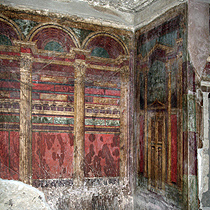 1
1Virtual Facades and distant Vistas (Architectural or Second style)
Vitruvius was quite vague as to who the ‘ancients’ were that began the practice of painting imitation marble, nor was he specific about when features other than imitation marble began to appear on the wall. What seems likely, however, is that over a period of a hundred years or so, the small repertoire of objects associated with the First Style increased to include architectonic features. As a result the planar characteristics associated with this style were eventually subsumed by spatial features that included architectural motifs and increasing amounts of figurative imagery. So much so, that by around 80-40 BC internal walls in some areas of the house began to look like the exteriors of buildings (fig.1). Mau named this development the ‘Architectural Style’ in line with Vitruvius’s description cited below and the evidence that was emerging from the Campanian sites.
“[1] (continued) … representing different kinds of marble slabs in different positions, and then cornices and blocks of yellow ochre arranged in various ways.
[2] Afterwards they made such progress as to represent the forms of buildings, and of columns, and projecting and overhanging pediments; in their open rooms, such as exedrae, …..”
Vitruvius Pollio (c.25BC), The Ten Books on Architecture (7.5.1-2) Morris Hicky Morgan ed. http://www.perseus.tufts.edu/cgi-bin/ptext?lookup=Vitr.+7.5.1
The Casa dei Grifi on the Palatine in Rome is often cited as an early example of a transitional phase between the First and Second style (fig.2). Its faux marble surfaces have all the characteristics of the Incrustation Style, but in addition it features architectural motifs such as architraves, cornices and pilasters. These motifs along with columns, pediments, arches, doors and numerous other architectonic features often mirrored the dimensions of the actual room, thus transforming it into a virtual as well as a physical space (fig.3). This was further emphasised by depictions of gates, porticos, doors, aedicula and windows, which allowed the viewer to see into virtual spaces beyond the confines of the physical room. In addition to depicting yet more architectural motifs that suggested rooms and buildings beyond that in which the viewer was located, the faux entrances also led the viewer's eye to sanctuaries inhabited by divinities, bucolic idylls and mythological narratives (fig.4&5). In addition to juxtaposing interior (physical) and exterior (virtual) space, the domus's interior 'pictorial' skin created an ambiguous relationship between everyday domestic life and the metaphysical worlds that appeared beyond its walls.
|